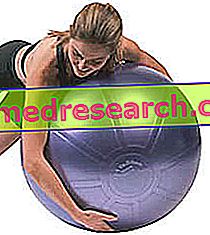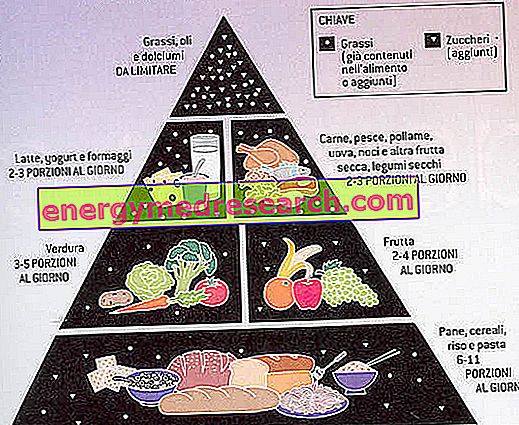Edited by Antonio Sellaroli
The swiss ball (also known as Swiss ball or fitball) was developed in the early 1960s as a toy for children; soon, however, it became a tool of frequent use in the physiotherapy field, adopted to improve the mechanisms of proprioception and patient balance. Today, the swiss ball is frequently used by athletic trainers and personal trainers, in order to integrate their muscle strengthening and coordination programs; some physiological mechanisms, in fact, are positively influenced by the stresses transmitted by the swiss ball.

Let us now try to clarify the reason for these improvements, first of all dealing with those who are the protagonists of the physiological systems involved.
The perfect machine known as the human body possesses multiple sensory capacities, which allow one to express appropriate motor functions; all these abilities are enclosed in the term "proprioception".
The proprioception concerns the ability to perceive the movement and position of the joints in space. This ability helps to manage the motor patterns of neuromuscular control, necessary to perform precise movements; it also contributes to the muscular reflex and contributes to dynamic joint stability. For example, an athlete's ability to maintain balance - after being unbalanced in a dynamic game situation - requires coordinated activation of various muscles and an appropriate level of strength; in other words it requires excellent proprioceptive abilities. But why and how is this made possible? When the balance is disrupted, the receptors distributed throughout the body experience a modification of the tissue in which they are found and send this variation to the CNS; after the brain has developed the best motor scheme to react to imbalance, contraction and inhibition signals are sent to the muscles, which produce the compensatory movement.
The receptors involved in these situations are the neuromuscular spindles, the Golgi tendon organs and the articular receptors.
- The neuromuscular spindles are receptors sensitive to the length and intensity of the stretch, which stimulate muscle contraction when they reach their excitation threshold. The neuromuscular spindles are found inside the muscles, arranged in parallel with the bundles of muscle fibers; in this way, when the muscle lengthens reaching a certain length at a certain speed, the muscular spindle feels the variation and sends a signal to the spinal cord; in response to this stimulus, the affected muscles receive a message, which initiates a reflex contraction (myotactic reflex) of the stretched muscle, and a relaxation of the antagonist muscle.
- Tendon organs are receptors that are sensitive to stretching of the tendons, following the contraction of the muscles to which they are connected.
Tendon organs are located in the muscle-tendon junction. Following a muscle contraction their sensory fibers are activated and send the signal to the spinal cord; in response to this stimulus, the contraction of the corresponding muscle (inverse myotatic reflex) is totally or partially inhibited. It is therefore a protection mechanism used by the body to avoid excessive tendon tensions, which can lead to tearing.
- The articular receptors inform the nervous system on the joint angle, on the angular acceleration during the movement and on the degree of deformation of the joint compressed by the forces involved in the movement. The joint receptors thus collect a large amount of data relating to the position of the body in space, the mode of movement and the joint load.
Adding to this complex and highly efficient data collection system is the valuable contribution of the visual and auditory organs. The perception of an incoming shot or an alert signal, for example, allows the body to prepare for action.
We now explain how such a simple tool, like the swiss ball, can stimulate all these reflexes of production and movement control.
As mentioned at the beginning of the article, the swiss ball is used for strengthening muscles and for correcting deficiencies in neuromuscular systems; the activities used to compensate for these deficiencies consist in sudden alterations of the articular positions, since these situations require the intervention of the neuromuscular reflex. Thanks to the spherical shape of the swiss ball, using this tool it is possible to create sudden alterations of the body position and various imbalances. Obviously, as in all programs that aim at success, the secret - which is then secret - is not the personalized and targeted administration of the exercises on swiss ball, establishing their duration, difficulty level and training volume. These are just some of the variables to be taken into consideration, as the goals and abilities of a middle-aged and sedentary subject, for example, are certainly not the same as those of a young athlete preparing a race.
Summarizing the various benefits of a training program with the help of swiss ball, we recall the improvement of the proprioception systems and the ability to stimulate the deep and stabilizing muscles, with a consequent increase in strength and joint health. Through the increase in the number of motor units involved in the movement, and to a higher excitation threshold of the Golgi organs that inhibit these fibers, a better control of the center of gravity is obtained, therefore of the ability to balance, speed and coordination .
I hope that after reading this short and simplified article on swiss ball, whoever decides to use this beautiful and amusing tool will do it with greater knowledge, not only of the routine of exercises to follow but also of the objective that these exercises set themselves.



